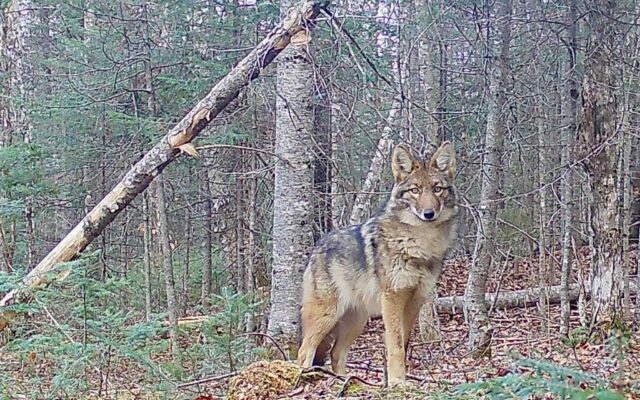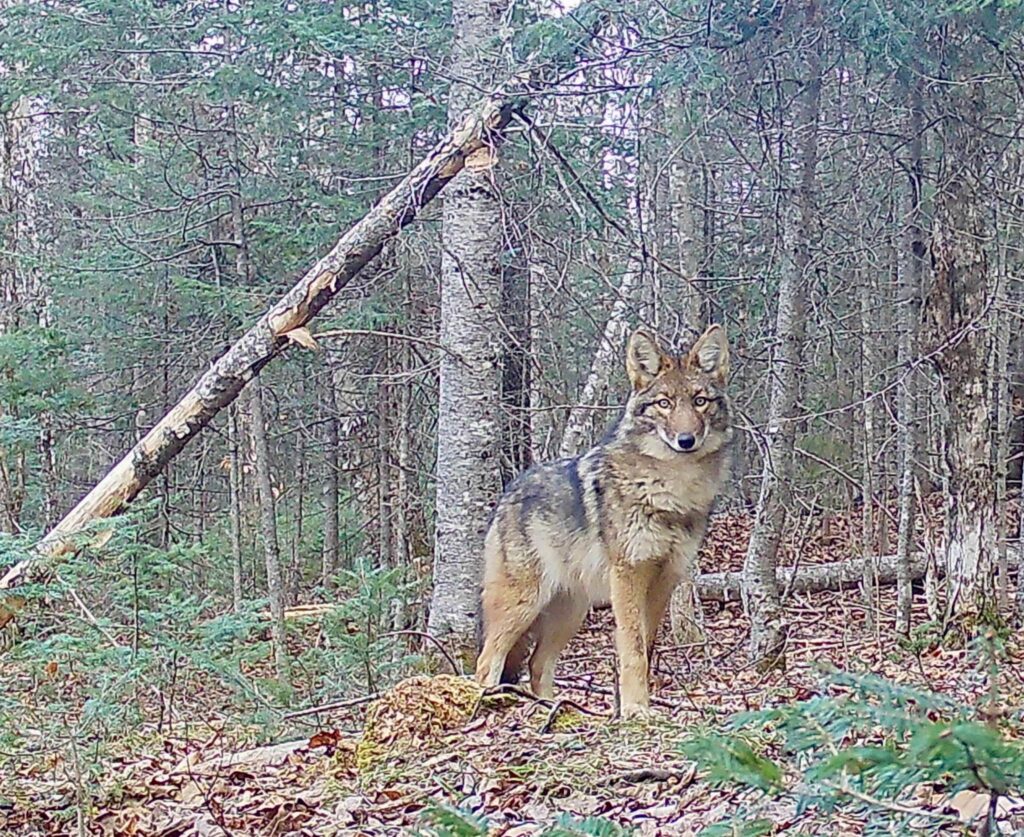
The most controversial animal in Maine
By Pete Warner, Bangor Daily News Staff
There are few things that frustrate Maine deer hunters more than the Eastern coyote.
Coyotes are efficient predators that kill deer, hare and other animals, and also eat carrion, fruits and plants. Through the centuries, coyotes have often been vilified. They have a reputation as killers, especially among hunters, farmers, and people whose pets have disappeared.
“I don’t care how invested I am in a hunt of any kind,” said Maine hunter Collin Hill. “If I see a coyote, I’m coyote hunting. We’re infested with them.”
Coyotes’ existence throughout the state puts them at odds with deer hunters, who frequently blame the coyotes for killing the deer that they want and deny them a chance to provide venison for their families. But the data is not clear enough to support these fears, as the state struggles year after year to achieve its deer harvest goals and insists coyotes are critical to maintaining a healthy ecosystem.
Biologists believe there are between 10,000 and 12,000 coyotes in Maine, but admit that’s a rough estimate. And while the Maine Department of Inland Fisheries and Wildlife concedes that coyotes kill deer, it doesn’t consider coyotes a threat to game populations, especially given the abundance of deer in southern and central Maine.

EASTERN COYOTE — This Eastern coyote peers at Keith Dirago of Mainely Wildlife Photography during an encounter near Stacyville.
“They’re an important predator,” said Shevenell Webb, furbearer biologist for DIF&W. “All predators have ecological value, just like all prey have important ecological value.”
The state is in the process of finalizing its 2020-2030 Furbearer Management Plan, which includes details about management of coyotes and 15 other species. It includes the results of a recent coyote survey that shows the public is less tolerant of the animals.
The survey showed that Maine’s trappers and hunters believe they know a great deal about coyotes, and they find the animal to be the least beneficial when comparing 10 furbearer species.
And since coyotes are skittish around humans, most evidence of them chasing or killing deer comes from hunters.
“I have seen them kill the whole group of deer that was in my area,” said Scott Salley of Pittsfield. “A couple years ago, [coyotes] pushed them out on a small pond and killed five.”
Management efforts for coyotes must address several factors, DIF&W said. They include how killed coyotes are used, Mainers’ perceptions of coyotes and minimizing coyotes’ interactions with people.
“I think that attitudes are starting to change, but it’s a slow process that takes generations to do,” Webb said. “But I do think the public survey does reveal that those negative attitudes are still fairly pervasive for coyotes, so we have our work cut out for us.”
The history of coyotes in Maine
Hatred toward wild canine species stems from settlers who brought their beliefs about wolves to North America — the only place coyotes are found.
“Europeans really had no idea of the immense value of carnivores and the role they play in ecosystems, so they annihilated them,” Geri Vistein, a conservation biologist and the director of The Coyote Center, said. The Maine nonprofit’s mission is to enhance awareness of the value of carnivores and their relationship to humans. “A lot of it had to do with their religious concepts, that the wolf was actually the devil.”
That was in contrast to the native peoples of North America, who revered and respected coyotes and wolves, Vistein said.
Wolves dominated the woods for centuries but by the late 1800s, they were nearly wiped out. That opened the door for coyotes, which were first documented in Maine in 1936.
“What’s really interesting about coyotes is how adaptable they are to live in such a wide variety of landscapes and habitat types and take advantage of different food sources,” Webb said.
Only three or four generations of Mainers have lived among coyotes, but it didn’t take many sightings of one with a dead fawn in its jaws, or chasing a deer, to make Mainers despise them.
Coyote attacks on people are rare in the state, but biologists say hunting and trapping help make the animals more wary of humans and also reduce conflicts with pets and livestock.
Coyotes kill deer in some areas more than others
Coyotes are the No. 1 cause of deer deaths in northern Maine, accounting for 50 percent of cases in Wildlife Management District 1, according to the state. The farther south the study, the lower the ratio.
State officials and hunters agree deer can be more vulnerable to coyotes because of deep snow in regions such as Aroostook County, where forested habitat that provides deer with food and some protection from deep snow and predators has been lost to overharvesting.
“It’s not just one factor, it’s multiple factors,” Webb said. “But coyotes are likely a part in suppressing deer because northern Maine’s a really tough place to live in the winter if you’re a deer.”
The state encourages people to kill coyotes. From 1985 to 2002, it paid people to catch them in wire neck snares.
In February 2018, retired Maine wildlife biologist Ron Joseph wrote a Letter to the Editor in the Bangor Daily News suggesting the snaring program emerged thanks to timber industry lobbyists, whose campaign contributions swayed Legislators to vote against protecting deer habitat and instead allowed hunters to kill more coyotes.
The initiative, Joseph said, removed many coyotes in some locations, but cost the state $680,000. Snaring was discontinued in 2003 in part because federally protected Canada lynx, bobcats, fishers, bald eagles, deer and even hunting dogs fell victim to them.
The state continues to fund a predator management program in more than 50 deer wintering areas, resulting in 297 coyotes killed per year, at an average cost of almost $52,000, or $174.62 per animal, since 2011.
Coyote hunting opportunities abound
There isn’t much standing in the way of hunters who want to kill coyotes. Maine law allows coyotes to be hunted or trapped, and their pelts sold with few species-specific restrictions.
Daytime hunting of coyotes is permitted year round. Coyotes, along with raccoons, are the only game animals that can be legally hunted at night during an 8 1/2-month season.
Coyotes are also the lone exception to the state’s wanton waste law, which makes it illegal to leave an animal that has been wounded or killed in the field.
But recent changes in the law have been favorable to coyotes. In 2019, the state changed the law to allow killed coyotes to be gifted to other people, who may then register them and use or sell the fur, rather than discard the carcasses.
A bill, LR 192, An Act to Restrict the Daytime and Nighttime Killing of Coyotes, will be introduced in the Legislature this session by Rep. Lynne Williams of Bar Harbor that would prohibit all coyote hunting from April 1 to Sept. 30, Vistein said. Such a law would be a concession to animal activists and conservationists who want to take hunting pressure off coyotes.
More Mainers are advocating for coyotes
Biologists and conservationists, along with some hunters, hope that a better understanding of coyotes may create a greater sense of public tolerance and acceptance.
“They’re clearly the most maligned and misunderstood animal, I think you could objectively argue, in this whole country” said C.J. Dirago, an avid deer bowhunter who enjoys harvesting venison. It wasn’t until the pandemic hit that he began reading up on coyotes. “And that just didn’t make sense to me.”
The real estate planner and consultant now wants to focus his career on conservation issues.
“As a deer hunter and as a Mainer who’s an outdoorsman, to be able to offer a different story about this animal, which helps balance the ecosystems when they’re present, is important,” he said.
For example, coyotes that prey on deer help lower the population, which limits the spread of deer ticks and Lyme disease, Vistein suggested.
When Master Maine Guide David Kelso of South Paris began working at a coyote research center, it changed his perspective on hunting the animal.
“After being able to go in the pens and play with them, I got so I could not walk up to one in a trap,” said Kelso, who has hunted coyotes.
Kelso still believes some coyote harvesting is needed and suggested hunters not shoot those that appear to have mange, which he said infects and kills more coyotes than hunters ever could.
The coyote debate will continue. More education about how they live may dispel some misunderstandings, but hunters’ perceptions that coyotes kill the deer they’re targeting will keep playing a pivotal role in forming public opinion.
Coyotes are here, and Mainers have to learn to live with them.
“It’s a species that has demonstrated that it’s here to stay. It’s not going anywhere,” Webb said.